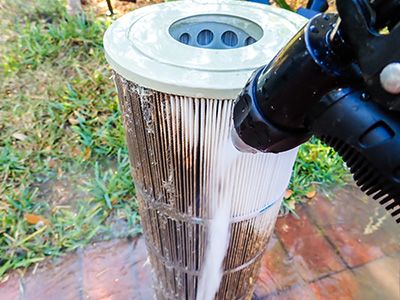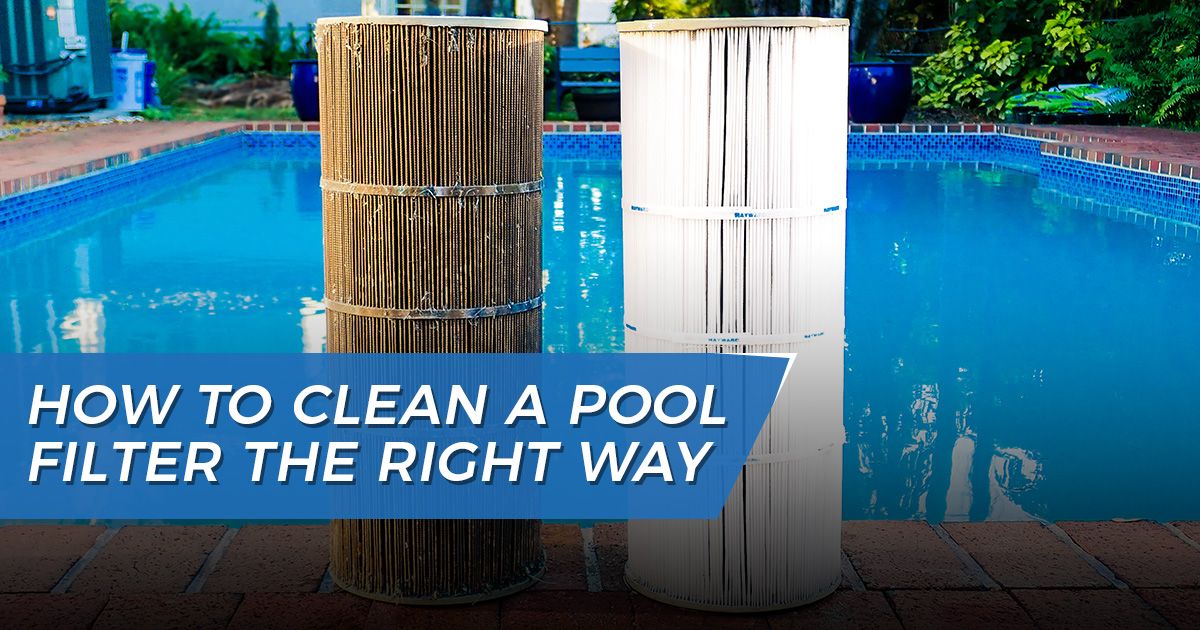How to Clean a Pool Filter the Right Way
In order to keep your water clean and crystal clear, it’s time to learn how to clean a pool filter. This often overlooked but essential task is easy to do yourself and critical to the health of your pool. But, how often should cleaning happen? If you’re a beginner, we have you covered.
Pool Filter Cleaning: Why It’s Necessary

The average life of your filter is around two years, and that’s highly dependent on how well you clean and maintain it. Did you know that using suntan lotion, deodorant, and other chemicals can decrease its lifespan almost in half? While we are not advocating you forgo the suntan lotion, we did want to take time to address the importance of and maintenance habits for a healthy, clean pool. If you neglect your filter, you are sure to increase debris and dirt and, let’s face it, dirty water isn’t any fun to swim in.
Did you know that it’s also made to keep you healthy? When it’s at its best, it will clean out bacteria and prevent it from accumulating. If neglected, this becomes a breeding ground for dangerous bacteria and compromises your safety. It’s clear to see that cleaning is an essential part of your pool’s health – and yours.
How To Clean a Pool Filter
While it’s essential to follow proper maintenance habits to increase its lifespan, it’s also important to understand which type you have in order to clean and maintain it properly. There are three main types: cartridge, D.E, and sand filters; and each one has a different cleaning method.
How To Clean Your Cartridge Filter
Cartridges are the easiest to clean and maintain, and only require deep cleaning one or two times per year. If your pool is large or gets a significant amount of use, you may want to consider cleaning it more often, though. We carry over 20 cartridge pool filters, so let’s break down the cleaning process for those first.
In order to prep for cleaning, grab a few household items. You’ll need a hose, spray nozzle, cleaner, a large bucket, and a replacement o-ring, and replacement cartridge, if needed. Don’t forget your owner’s manual, too!
Start by turning off your pump, system, and your air relief valve. Turn the air relief valve off slowly to release any trapped air. Next, release the mechanisms holding everything together, remove the top filter, and set the cartridge aside. This is one of the times you may want to refer to your owner’s manual. There might be a certain way to release the filter to ensure you don’t cause any damage.
Once you’ve set everything aside, you’ll need to perform a quality assurance check. This is the time to inspect it for cracks or damages that would require the use of a new o-ring or cartridge.
Cartridges are easily cleaned with your garden hose and cleaner. If you find that it’s not getting clean enough with these methods, you can always let it soak overnight in your cleaning mixture. Make sure that it is rinsed thoroughly, replace, and then secure it.
Be sure to turn everything back on, check the air relief valve, and double check the system pressure. If you think your pounds per square inch (PSI) seems wrong, you may not have put it back together quite right. Try again, following the owner’s manual very closely.
How To Clean Your D.E. Filter
A D.E. filter should be cleaned at least once per month, or when you notice that the water is starting to look cloudy. You’ll want to grab your hose, some cleaner, and a bucket again for this one.
Start by backwashing your filter to remove debris, and then turn the pump off and open the air relief valve. Remove the drain plug and then remove the clamps after the water has completely drained. Once the clamps are removed, open the tank, remove the manifold, and take out all the grids. Then you’ll want to use the hose to rinse the tank. Again, your owner’s manual would come in handy here.
When cleaning your D.E. filter, you’ll also want to clean the manifold, potentially using D.E. cleaner for really difficult jobs. Using your garden hose, rinse the manifold and the grids, ensuring all debris and cleaning solution are removed. Place the grids back into the tank, add D.E. powder, and run the pool pump for at least 30 minutes.
If the job seems like an intense one, you can also clean with muriatic acid. This would only need to be done once per year and is a bit more dangerous, so we highly recommend taking caution, following directions exactly, and even resorting to the professionals if this seems like a necessity. If you decide it’s a job you’re willing to take on, please remember to wear safety goggles and gloves when performing the task.
How To Clean Your Sand Filter
A sand filter is the hardest type to clean. You can either backwash it or clean it with the right chemicals. The easiest ways to tell if cleaning is necessary is if you notice that your pool is 10 PSI over its normal limit, or if it is beginning to look a bit cloudy.
To begin cleaning, you’ll need a hose, some cleaner, and your owner’s manual. You’ll want to start by backwashing for a few minutes to remove debris. After this, turn off the pump and turn the valve to filter. Pour in your cleaner, turn the pump back on for a few seconds so that the cleaner makes its way into the filter, and then turn the pump off again. You’ll want to leave it off overnight.
After leaving the cleaner overnight, you’ll need to backwash one more time. Again, this usually takes a few minutes, so be sure to do a thorough job. Once debris and dirt are removed, you can turn the system back on and use your pool as you’d like.
Again, this can be difficult to work with and it’s tough to know if you’ve done it properly. Trained technicians are capable of ensuring each step is followed exactly as needed and that everything is clean enough to begin working again. Never hesitate to turn over this potential DIY job into the hands of professionals.
When Cleaning Doesn’t Seem to Be Enough
Not sure if it’s time for a complete change? Your pool will let you know when it needs to go. If there is a high PSI reading or is accumulating debris quickly, it might be time for a replacement. As mentioned before, if it looks worn, cracked, or the cartridge is crushed, it is time for a change.
Changing your filter can be done in four easy steps:
- Safety first! Make sure to turn off all the electricity going to your pool. Assess the location to make sure it’s dry and safe to work on.
- Open the release valve and take the restraining band off of your pump.
- Locate the filter and remove it carefully. After you have discarded the old one, replace it with a new one, and be sure to put it in tightly.
- Reset your valve and ensure that it is secured tightly. Now you can proceed to turn on your electricity and make sure the pump works.
Skip the DIY Tips and Call the Pros
Not a DIY kind of person? That’s okay! At GPS Pools, we’ll handle your filter cleaning for you. We can install or repair and help keep your pool looking crystal clear all year long. Fill out the form on our contact page and we’ll be happy to take a look for you.

